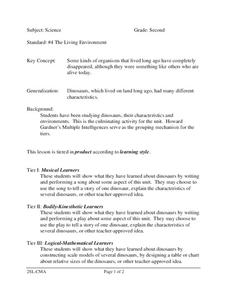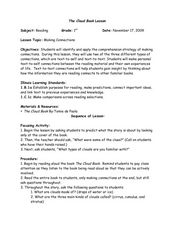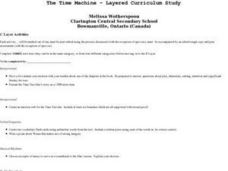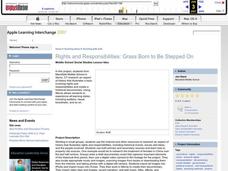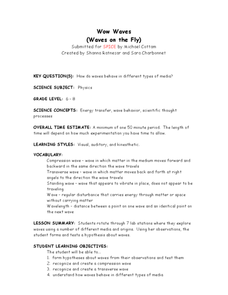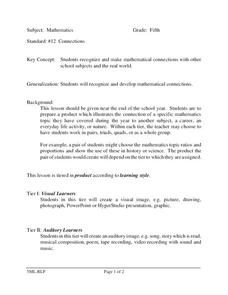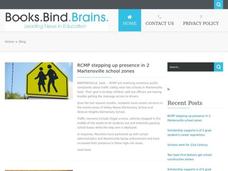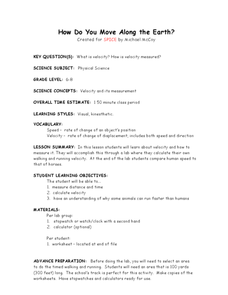Curated OER
Four Learning Styles
Students play a game where they insert the states of the United States onto a map, and discuss the four learning styles as they play. In this learning styles lesson plan, students discuss how each learning style would play and think...
Curated OER
Hula How?
Third graders start writing papers with much more regularity than they did in the previous grades. They are starting to differentiate between the styles of writing and know why each is important. This activity gives the them a chance to...
Curated OER
See It, Say It, Move It, Do It!
Learn two new letters a week with this activity! After learning the two target letters, the class will make an alphabet video "performing" each letter. The letter's name, sound, and a motion associated with it will be included in the...
Curated OER
The Living Environment
Sixth graders show what they know about plant and animal cells. In this cell project instructional activity, 6th graders get to choose a project based on their learning style. They can create a visual representation of cells, auditory...
Curated OER
The Living Environment
In this reading comprehension lesson, 2nd graders have the choice between musical, kinesthetic, logical mathematical and verbal linguistic options to display their knowledge. Students can write a song, perform a play, construct a model...
Curated OER
Making Connections
Fifth graders take part in activities that appeal to many learning styles (kinesthetic, verbal, etc...) to help them create a Venn Diagram to compare/contrast state and national government.
Curated OER
The Time Machine - Layered Curriculum Study
Pupils complete three activities of their choice from a given list surrounding their study of H.G. Wells' novel, The Time Machine. They choose activities from each of the seven learning styles.
Curated OER
Listening and Speaking
Ninth graders practice the elements of narration. In this narration activity, 9th graders complete learning profile activities to address kinesthetic learners, artistic learners, musical learners, and interpersonal learners. Students...
Curated OER
History of Huguenot Street
Sixth graders research the history of Huguenot Street and visit the street as a class field trip. They, in groups, present their research and observations in a skit format.
Curated OER
Exploring Magnets and Magnetism
Here is a very good lesson on magnets, magnetism, and magnitic fields that is chock full of great activities for you to implement with your young scientists. Learners discover the properties of magnets, look at the forces of attraction...
Curated OER
The History of Life on Earth
Using meters as years, your class works together to map out the geologic time scale on a football field. Plenty of background information is included in this lesson plan as well as several resource links and a student worksheet. Your...
Curated OER
"If you build it..."
Young scholars utilize prior knowledge to erect and assemble a building from a drawing using spaghetti noodles and marshmallows. In this building instructional activity, students visualize a three dimensional structure from looking at a...
Curated OER
Shake, Rattle, and Roll
Students make an earthquake simulator and test their structure to see if it lasts through the earthquake. In this earthquake lesson plan, students make a structure and test and record the results from an earthquake simulator made out of...
Curated OER
Rights and Responsibilities: Grass Born to Be Stepped On
Students use the Internet and other resources to research an aspect of history that illustrates rights and responsibilities, including historical events, issues and ideas, and the people involved.
Curated OER
Machines: Designing Form and Function
Students design a boat model with simplified steam engine. For this ecology lesson, students compare renewable and nonrenewable energy sources. They determine the efficiency of their boat model.
Curated OER
Go Car, Go!
Students design and build their own car. In this physics lesson, students collect data to determine the speed of the car. They plot the data on the graph analyze the relationship between variables.
Curated OER
Wow Waves (Waves on the Fly)
Students formulate hypotheses on wave behavior and test them. In this physics lesson, students compare and contrast transverse and compression waves. They determine the wavelength of transverse waves.
Curated OER
Connections
Fifth graders create a musical composition, a drawing, or a 3D structure to show how math connects to other subjects. In this math and other subjects lesson plan, 5th graders present their presentations to the class and explain the...
Curated OER
Measuring Rainfall and Relationships Between pH, Alkalinity and Suspended Solids in the Pago River
Eleventh graders test the pH and alkalinity of Pago River. In this ecology lesson, 11th graders collect data and use spreadsheet to graph results. They analyze and share their findings with the class.
Curated OER
The Envelope Please
Students examine and research the importance and functions of the skeletal system in vertebrates. They construct a 10-foot geodesic dome to illustrate the importance of architectural frameworks and create a clay animation movie.
Curated OER
Governance
Students explore government by researching Native American history. In this First Nations culture lesson, students define the Aboriginal action of speaking in a circle as a group. Students discuss their likes and dislikes with the class...
Curated OER
How Do You Move Along the Earth?
Students determine their own walking and running velocity. In this physics lesson plan, students calculate velocity using distance and time information. They compare human and animal speeds.
Curated OER
Marble Madness
Students determine the velocity of a marble rolling down the incline. In this physics instructional activity, students identify the independent and dependent variables in the experiment. They construct and analyze a graph.
Curated OER
Mathematics: Technology and Connections
Sixth graders interpret and replicate patterns. For this patterns lesson, 6th graders are given an item with a definite pattern which they must replicate using a calculator or computer and then justify how they relate. Students...




